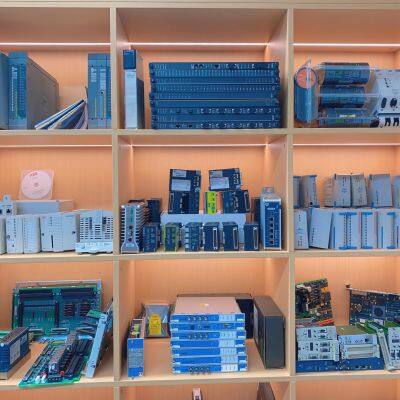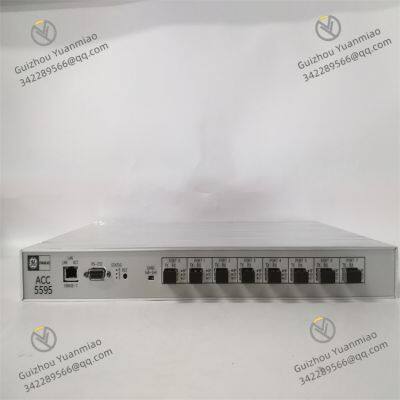Product Description
I. Overview
GE ACC - 5595 - 208 350 - 805595 - 208 is a high-performance reflective memory hub component, meticulously developed by General Electric. In complex industrial environments with extremely high real-time requirements, the fast and accurate transmission of data is crucial. With its excellent performance, this product has become a core device for building reliable data communication networks, widely used in various industrial control systems, and provides a solid guarantee for the efficient advancement of the industrial automation process.

II. Technical Parameters
Physical Specifications: The hub component has dimensions of 241×194×152mm. This volume design fully considers the installation space such as industrial control cabinets and equipment racks. It can find a suitable installation position relatively easily, whether in a compact small control system or a large and complex industrial automation architecture. It weighs about 1kg. The moderate weight ensures the stable installation of internal precision components, and also facilitates installation and maintenance personnel to carry, install, debug and other operations on the equipment, without bringing too much burden to the overall structure of the equipment.
Data Transmission Rate: It has a data transmission rate of up to 2Gb/s. This high-speed performance enables devices connected to its network to achieve instant data exchange. In industrial automated production lines, a large amount of sensor data, equipment operation status information and control commands need to be transmitted in a very short time. The data transmission rate of 2Gb/s can easily meet such scenarios with high real-time requirements, ensuring the efficient and stable operation of the production process.
Interface Configuration:
SFP Ports: Equipped with up to 8 Small Form-factor Pluggable (SFP) transceiver ports, these ports greatly enhance the connection flexibility of the device. Through SFP ports, it is convenient to connect different types of optical fibers or copper cables to meet the needs of various network transmission media. Whether in industrial parks that require long-distance transmission or in electronic equipment production workshops sensitive to signal interference, reliable data transmission can be achieved by selecting appropriate SFP modules.
Ethernet Port: There is 1 10Base-T Ethernet port, which allows users to remotely monitor and control the device through a Local Area Network (LAN). With the wide application and convenience of Ethernet, operators can easily access the management interface of the hub component through a web browser in the office or remote control center, view device status, configure parameters and perform fault diagnosis in real time, which greatly improves the efficiency and convenience of device management.
RS232 Port: It has 1 RS232 port, mainly used for monitoring and controlling the network through a simple PC serial port connection. In some industrial sites, a stable network environment may not be available, or in the early stage of equipment debugging, it is necessary to use the RS232 serial port for underlying device configuration and fault Investigation. The RS232 port provides a reliable communication method for these scenarios, ensuring that the device can be effectively managed and maintained under various conditions.
Network Expansion and Distance Support: It supports network cascading. Multiple VMI ACC - 5595 components can be used in cascade, so that the number of network nodes can be expanded to up to 256. This strong scalability makes it possible to build large-scale and complex industrial automation networks, and can meet the production needs of enterprises of different scales. At the same time, the maximum configurable cable length of this hub component is up to 10km, which makes it have great advantages in scenarios such as large industrial plants and cross-regional industrial facilities. Even if the physical distance between devices is relatively far, stable data communication can be realized through long-distance cable connections, which effectively reduces the network layout problems caused by distance limitations.
Power Supply: It adopts an internal universal power supply, which can adapt to the power input requirements of different regions and industrial environments. Whether in an industrial power environment with large voltage fluctuations or in complex projects that need to access multiple power standards, the internal universal power supply can ensure the stable operation of the device, without the need to configure additional complex power conversion equipment, reducing the equipment use cost and maintenance difficulty.

III. Functional Features
Reflective Memory Technology: It adopts reflective memory technology at its core, enabling all nodes in the network to share the same memory space in real time. This means that when one node updates the data in the memory, all other nodes can immediately perceive and obtain the latest data without going through complex data transmission protocols and intermediate processing links. In industrial automated production lines, various devices need to synchronize data in real time. For example, a robotic arm needs to adjust its actions according to the real-time workpiece position information fed back by sensors. Reflective memory technology can ensure that this data synchronization is completed within microseconds, thereby realizing precise control of the production process and improving production efficiency and product quality.
Automatic Node Bypass: It has the function of automatically bypassing defective or disconnected nodes. In industrial environments, due to the influence of factors such as vibration, electromagnetic interference and temperature changes, some nodes of equipment may fail. When a node is detected to be faulty or disconnected from the network, GE ACC - 5595 - 208 can automatically bypass it, allowing other nodes in the network to continue normal communication and ensuring the continuous operation of the entire network. This automatic fault-tolerant mechanism greatly improves the reliability of the system, avoids the risk of the entire production system being paralyzed due to a single node failure, and provides a strong guarantee for the continuous production of enterprises.
Signal Regeneration: Each port can regenerate the serial optical signal. In the process of long-distance data transmission, the signal will gradually weaken due to the attenuation and interference of the transmission medium, leading to data transmission errors or loss. The port signal regeneration function of this hub component can eliminate the insertion loss of the signal during transmission, effectively reduce signal jitter, and ensure the integrity and accuracy of data. Even when the cable length reaches 10km, through the signal regeneration of the port, data can be reliably transmitted to each node in the network, meeting the needs of long-distance and high-quality data transmission in industrial scenarios.
Remote Monitoring and Management: Remote monitoring and management of the device are realized through Ethernet and RS232 ports. With the Ethernet port, users can log in to the management interface of the device through a web browser to view the operating status of the device, network connection, port traffic and other information in real time, and can also remotely configure device parameters and upgrade firmware. The RS232 port provides users with a more underlying and reliable remote control method. In some special cases, such as network failures or the need for in-depth device debugging, effective control and monitoring of the device can still be carried out through the RS232 serial port connection. This remote monitoring and management function greatly improves the operation and maintenance efficiency of the device, reduces the on-site maintenance workload, and lowers the operating cost of the enterprise.

IV. Common Faults and Solutions
Network Connection Faults
Fault Phenomenon: Some nodes cannot connect to the hub component, or the network connection is unstable, with problems such as frequent disconnections and data transmission interruptions.
Possible Causes: Damaged network cables, such as broken outer skin or internal wires of network cables, resulting in blocked signal transmission; faulty SFP transceiver modules, which may not work normally due to aging, overheating or incompatibility; loose ports and insecure connections, affecting the normal transmission of network signals; incorrect network configuration, such as IP address conflicts and improper subnet mask settings, making the device unable to communicate correctly in the network.
Solutions: First, carefully check the network cable for obvious physical damage. If there is any damage or breakage, replace it with a new network cable in time. For SFP ports connected with optical fibers, check whether the optical fibers are bent or broken. Then, check the SFP transceiver module, try to pull it out and reinsert it to ensure correct installation. If the problem persists, replace it with a known normal SFP module for testing to determine whether it is a module fault. Then, check the port connection, re-plug the network cable to ensure a tight port connection. Finally, check the network configuration parameters to ensure that settings such as IP address and subnet mask are consistent with the network environment and avoid conflicts with other devices.
Abnormal Data Transmission
Fault Phenomenon: The data transmission speed is slow, much lower than the normal 2Gb/s rate; packet loss occurs during data transmission, resulting in damaged data integrity; or data errors, such as checksum errors, occur during data transmission.
Possible Causes: Insufficient network bandwidth, which may be due to the excessive amount of data transmitted in the network at the same time, exceeding the carrying capacity of the hub component or network links; electromagnetic interference, there are a large number of electromagnetic devices in the industrial environment, such as motors and frequency converters, which may interfere with network signals and affect data transmission quality; port or device faults, such as a damaged port of the hub component or a hardware fault of the connected device, leading to abnormal data processing.
Solutions: For the problem of insufficient network bandwidth, network monitoring tools can be used to check the network traffic and analyze whether there is abnormal traffic occupation. If the amount of data transmitted in the network at the same time is too large, consider optimizing the network architecture, increasing network bandwidth, or adjusting the data transmission strategy to reasonably allocate network resources. For electromagnetic interference, check the routing of network cables, keep the network cables at a certain distance from strong electromagnetic devices as much as possible, or use shielded network cables to reduce electromagnetic interference. If a port or device fault is suspected, use the replacement method to connect the device connected to the suspected faulty port to other normal ports for testing. If the problem is solved, it indicates that the port is faulty, and the port of the hub component needs to be repaired or replaced. For the connected devices, check the hardware status of the devices, such as signs of overheating and hardware damage, and repair or replace the devices if necessary.
Abnormal Automatic Bypass Function
Fault Phenomenon: When a node in the network fails or is disconnected, the hub component fails to automatically bypass it, resulting in the interruption of the entire network communication; or after the automatic bypass function is activated and the network returns to normal operation, the faulty node cannot be automatically reconnected after being repaired.
Possible Causes: The device firmware version is too low, which may have software vulnerabilities, affecting the normal operation of the automatic bypass function; hardware faults, such as damage to the fault detection circuit of the hub component, making it unable to accurately detect node faults; complex network topology, which may have loops or other abnormal situations, interfering with the judgment of the automatic bypass function.
Solutions: First, check the firmware version of the device, log in to the management interface of the device, and check whether there is an available firmware update. If so, follow the upgrade guide provided by the device manufacturer to update the firmware to the latest version to fix possible software problems. If the problem persists after the firmware update, contact professional maintenance personnel to test the hardware of the hub component, focusing on checking whether the fault detection circuit works normally. For network topology problems, carefully check the network wiring to find out if there are network loops. Network topology discovery tools can be used to conduct a comprehensive analysis of the network structure, find out possible abnormal connections, and rectify them. After the faulty node is repaired, try to manually reconnect it through the device management interface and observe whether the automatic bypass function can recover normally.
Remote Monitoring and Management Faults
Fault Phenomenon: It is impossible to remotely monitor and manage the hub component through the Ethernet or RS232 port, such as being unable to log in to the device management interface, or being unable to correctly obtain device status information and configure parameters in the management interface.
Possible Causes: Network connection problems, such as Ethernet port faults, incorrect network configuration, and broken network cable connections, resulting in the inability to access remotely through Ethernet; incorrect RS232 serial port parameter settings, such as mismatched baud rate, data bit, and parity bit settings with the device, making it impossible to establish an effective communication connection through the RS232 serial port; device management software faults, which may be due to incompatible software versions or software damage, resulting in the inability to interact with the device normally.
Solutions: For Ethernet connection problems, check the Ethernet port, network cable connection, and network configuration according to the troubleshooting methods for network connection faults. Ensure that the IP address of the device is in the same network segment as the local network and that there is no IP address conflict. For RS232 serial port parameter settings, carefully check the RS232 serial port parameters of the device to ensure they are consistent with the parameters of the connected PC serial port. Refer to the device user manual to reset the serial port parameters. If it is a device management software fault, try to uninstall and reinstall the device management software to ensure that the installed software version is compatible with the device. Before reinstalling the software, back up the configuration files of the device to avoid data loss. After the installation is completed, restart the device and management software, and try the remote monitoring and management operation again.


MVME374 VME bus single board computer
MVME5500-0163 High performance embedded processor board
MVME55006E-0163R Single board computer of VMEbus
GE ITM11A8XJ036645 Turbine System
MVME5500-0163-B VMEbus single board computer
GE IS200TSVCH2ADC MRP061873 Temperature Input Module
MVME162-14 Dual high VME module
GE IS200TSVCH2AED MRP246517 Power Module
MVME147SRF VMEbus single board computer module
GE IS200SPROH1AAB MRP663860 Processor Module
MVME2301 VME bus processor module
GE IS200PMCIH1ACC Digital Signal Generator Module
 yezi
Hi there! Welcome to my shop. Let me know if you have any questions.
yezi
Hi there! Welcome to my shop. Let me know if you have any questions.





